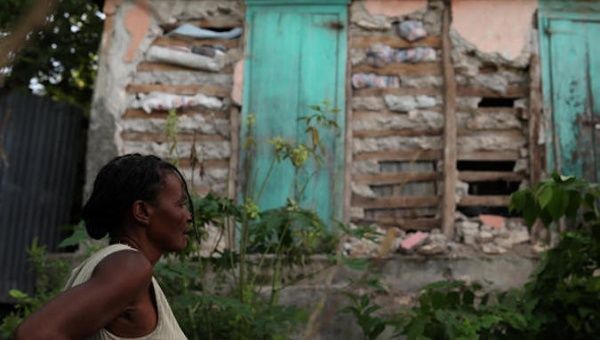34,000 Haitians Still Displaced 10 Years on from Quake
LATIN AMERICA AND THE CARIBBEAN, 13 Jan 2020
teleSUR – TRANSCEND Media Service
The head of the IOM’s mission in Haiti also discussed the modern-day threats and political instability many Haitians face which shares a border with the crisis-hit country.

The International Organization for Migration believes those internal refugees will remain permanently displaced. | Photo: Reuters
10 Jan 2020 – There are at least 34,000 people living in displacement camps 10 years after a devastating earthquake struck Haiti.
Just shy of a decade since the temblor brought the island nation to its knees on Jan. 12, 2010, the head of the IOM’s mission in Haiti, Giuseppe Loprete, told EFE about how the organization has intervened to help the population.
When the earthquake hit Haiti in 2010, there were 1.5 million displaced people in over 1,500 camps and displacement sites, he said.
“Now, we have about 22 displaced sites that are still open and 34,000 people still living in the situation of displacement, although we have to say that, after 10 years, for many of them this has become the normal situation.”
According to him, they are not either willing or do not have the possibility to move out of the displacement site, while some are even doing construction, trying to settle in these areas.
Related: Chile’s MPs Reject Proposal to Probe Troops’ Abuses in Haiti
In the camps, he reported that there was no electricity for most of the day, access to waters if difficult, there are areas that you can see just walking around that are very overcrowded, overpopulated.
Since the crisis has left 3.7 million people with food insecurity, there has been a boost in immigration, and a lot of people – at least one member of the family, mostly men between 18-35 years old – are looking for job opportunities, especially in Brazil but also in the Bahamas.
It is estimated that around 1.5-2 million Haitians are living abroad, corresponding to one-fifth of the population – mostly in Canada, the US, Brazil and Chile.
https://www.facebook.com/teleSUREnglish/videos/453091195361387/
Go to Original – telesurenglish.net
Tags: Corruption, Haiti, Latin America Caribbean, Poverty, Social conflict
DISCLAIMER: The statements, views and opinions expressed in pieces republished here are solely those of the authors and do not necessarily represent those of TMS. In accordance with title 17 U.S.C. section 107, this material is distributed without profit to those who have expressed a prior interest in receiving the included information for research and educational purposes. TMS has no affiliation whatsoever with the originator of this article nor is TMS endorsed or sponsored by the originator. “GO TO ORIGINAL” links are provided as a convenience to our readers and allow for verification of authenticity. However, as originating pages are often updated by their originating host sites, the versions posted may not match the versions our readers view when clicking the “GO TO ORIGINAL” links. This site contains copyrighted material the use of which has not always been specifically authorized by the copyright owner. We are making such material available in our efforts to advance understanding of environmental, political, human rights, economic, democracy, scientific, and social justice issues, etc. We believe this constitutes a ‘fair use’ of any such copyrighted material as provided for in section 107 of the US Copyright Law. In accordance with Title 17 U.S.C. Section 107, the material on this site is distributed without profit to those who have expressed a prior interest in receiving the included information for research and educational purposes. For more information go to: http://www.law.cornell.edu/uscode/17/107.shtml. If you wish to use copyrighted material from this site for purposes of your own that go beyond ‘fair use’, you must obtain permission from the copyright owner.
Read more
Click here to go to the current weekly digest or pick another article:
LATIN AMERICA AND THE CARIBBEAN: